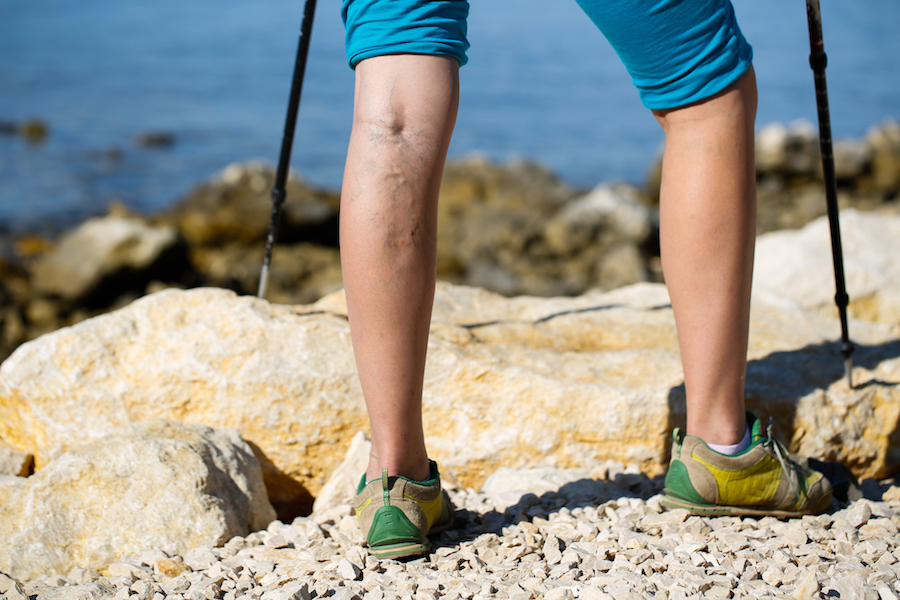Varicose veins: 6 things you need to know
Although rarely serious, varicose veins can be distressing and feel very uncomfortable.
And as one in three people develop the unsightly blue or purple bulging veins in their legs, it’s worth knowing what causes them and how to treat them.
Here are 6 things you need to know about varicose veins…

Anyone can potentially get varicose veins
1. What causes varicose veins?
The problem veins can occur at any age, even adolescence when valves in the leg or pelvic veins don’t work properly. After reaching the foot, blood needs to travel back up the legs to the heart, and the valves are designed to open and close one way to let the blood flow and to stop it going backwards. But if the tiny valves are weakened or damaged, blood pools in the veins, causing them to stretch and bulge – sometimes visible through the skin as a varicose vein.
The veins look blue because they contain deoxygenated blood on its way back to the lungs to be reoxygenated.
While 15-20% of UK adults have varicose veins which bulge from the leg when standing, another 15-20% have hidden varicose veins with inflammation at the ankle, caused by blood falling down the main leg veins.
2. Who gets them?
The reason the valves in veins are weakened or damaged isn’t fully understood, but while there may be no obvious reason for having varicose veins, there are some known risks, including…
Being female: Women are more likely to get varicose veins than men, possibly because female hormones can relax the vein walls, making the valves more likely to leak.
Genes: If you’ve got a close family member with varicose veins, you’re more likely to have them yourself.
“The most important thing in getting varicose veins is who your parents are,” says Professor Mark Whiteley, a consultant vascular surgeon from The Whiteley Clinic in London. “Genetics play a major role.”

Pregnancy can be a factor
Pregnancy: Pregnancy increases the amount of blood in the body but decreases its flow from the legs to the pelvis, so extra strain is put on the leg veins. There are also more hormones circulating, which relaxes the vein walls, and the growing womb puts pressure on pelvic veins which can become varicose.
Being overweight: This puts more pressure on the veins.
Getting older: Veins start to lose elasticity as you get older, and their valves get weaker too, making them more prone to leakage.
Standing for long periods: Being on your feet for a long time regularly, for example at work, increases the risk of developing varicose veins, or can make existing veins worse. This is because the veins have to work harder to combat gravity and get blood to flow up your legs.
Sitting for long periods: This leads to poor circulation in your legs, raising the risk of varicose veins.

They don’t always need treatment
3. Do you need treatment?
Varicose veins only used to be treated if they were really causing problems, but guidance from the National Institute of Health and Care Excellence (NICE) in 2013 stated that all patients with varicose veins – who are experiencing symptoms (typically pain, aching, swelling, heaviness and itching) or visual signs (skin changes such as pigmentation or eczema, the appearance of hard, painful veins, or a venous leg ulcer) – should be referred to a vascular service for a venous ultrasound, to establish which veins are causing the problem and to be offered a full range of treatments.

Treatment is relatively simple
4. What are the treatment options?
There might be a few treatment options, outlined here…
Thermal ablation: This uses heat from either a laser or radiofrequency to seal the vein from within.
Foam sclerotherapy: A special foam closes veins unsuitable for thermal ablation.
Stripping: This means veins are surgically removed. The third treatment option, this should only be offered if the patient is unsuitable for the other treatments, or if they aren’t available.
Professor Whiteley says: “All these treatments can be performed under local anaesthetic with no sedation, allowing patients to walk in and walk out, and reducing the risks.”
There are also newer, non-thermal techniques that need fewer injections. These include glue, where veins are simply sealed with a special glue, and mechanochemical ablation (MOCA, also called Clarivein).
Venous eczema cured @whiteleyclinic #veins #eczema #varicoseveins https://t.co/ngNkXMbjkL pic.twitter.com/zDXMnbCa8A
— The Whiteley Clinic (@whiteleyclinic) August 10, 2017
5. Can varicose veins come back after treatment?
Studies suggest 20% of women with varicose veins have problem veins coming from their pelvis, not their legs – and they often remain untreated and are a major cause of varicose veins recurring after treatment.
Failure to treat the tiny veins connecting the deep veins in the muscles to veins just under the skin can also lead to recurrent varicose veins, and when veins are stripped out, they can grow back again during the healing process. The new veins don’t have valves, so they automatically lead to new varicose veins.
6. Can varicose veins go away without treatment?
Regular exercise, wearing compression stockings and elevating the legs can all help reduce symptoms, but won’t get rid of varicose veins.
“There’s no way stockings, tablets, creams, diet, exercise, time or anything else apart from treatment can correct veins in which the valves have failed and the venous blood has started falling the wrong way,” stresses Professor Whiteley. “With time, the veins stretch more, more inflammation is caused and the condition worsens.”
The Press Association
Latest posts by The Press Association (see all)
- World Penguin Day: Test your knowledge with our penguin-themed quiz - April 23, 2024
- Kate’s new photo of Louis released to celebrate prince’s sixth birthday - April 23, 2024
- Alan Titchmarsh: Slugs are never going to be my friends - April 23, 2024
- Prince Louis celebrates sixth birthday - April 23, 2024
- Special episode of Planet Earth III to be narrated by schoolchildren - April 22, 2024






















